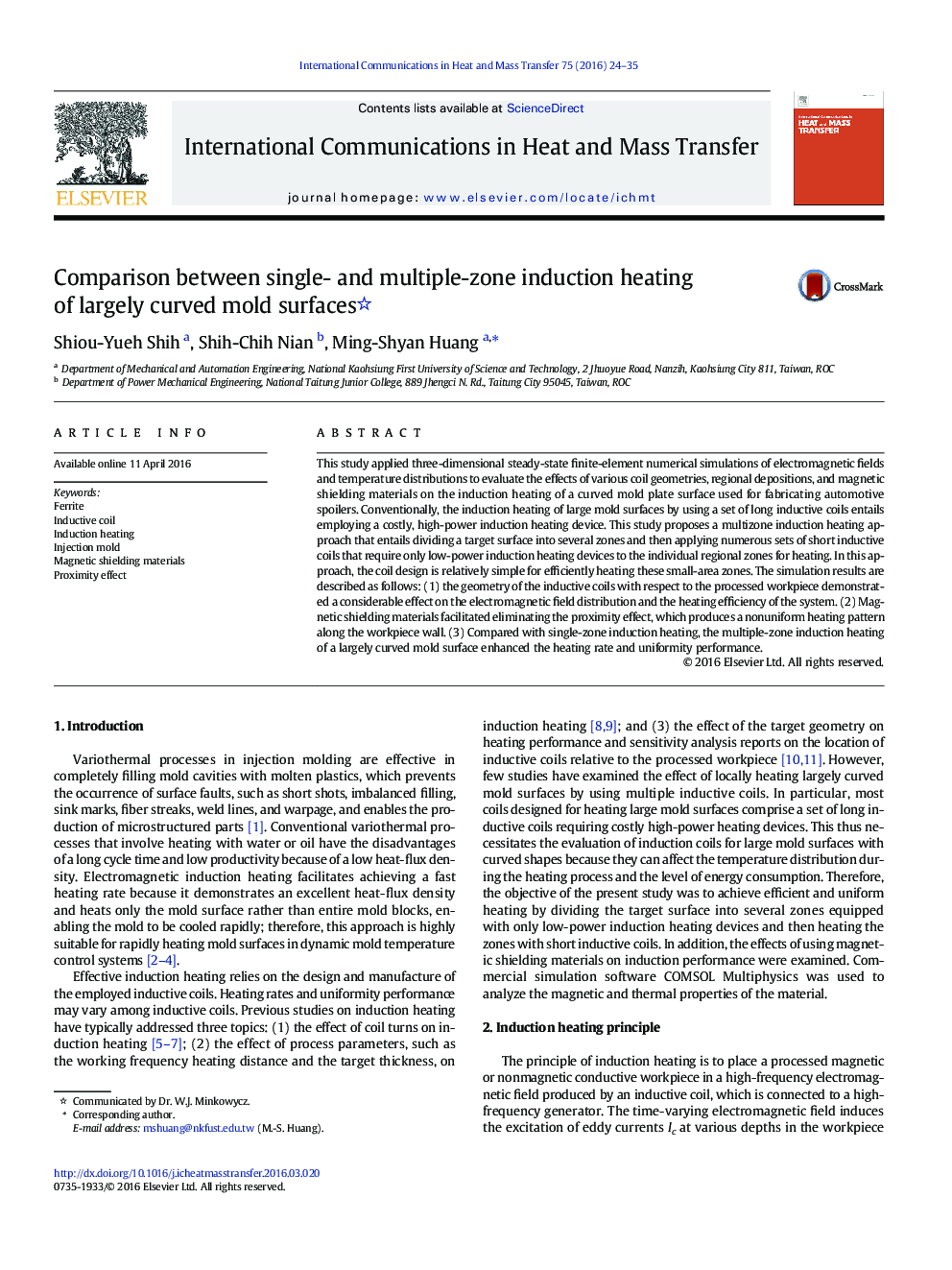| کد مقاله | کد نشریه | سال انتشار | مقاله انگلیسی | نسخه تمام متن |
|---|---|---|---|---|
| 7053249 | 1457479 | 2016 | 12 صفحه PDF | دانلود رایگان |
عنوان انگلیسی مقاله ISI
Comparison between single- and multiple-zone induction heating of largely curved mold surfaces
ترجمه فارسی عنوان
مقایسه گرمایش القایی تک و چند زون سطوح منحنی شکل منحنی
دانلود مقاله + سفارش ترجمه
دانلود مقاله ISI انگلیسی
رایگان برای ایرانیان
کلمات کلیدی
فریت، کویل القایی، گرمایش القایی، قالب تزریق، مواد محافظ مغناطیسی، اثر مجاورت،
ترجمه چکیده
در این مطالعه، سه بعدی شبیه سازی عددی محدود عنصر محدود از میدان های الکترومغناطیسی و توزیع دما برای ارزیابی اثرات هندسه های مختلف کویل، رسوبات منطقه ای و مواد محافظ مغناطیسی بر روی گرمایش القایی سطح سطح صفحه منحنی استفاده شده برای ساخت خودرو اسپویلرها به طور معمول، گرمایش القایی از سطوح بزرگ قالب با استفاده از مجموعه ای از کویل های انتزاعی طولانی، مستلزم استفاده از گرمای القایی با هزینه بالا و قدرت بالا است. این مطالعه یک رویکرد گرمایش القایی چند جانبه را پیشنهاد می کند که شامل تقسیم سطح هدف به چندین منطقه و سپس اعمال مجموعه های متعدد از کویل های القایی کوتاه است که فقط دستگاه های گرمایش الکتریکی کم قدرت را به مناطق منطقه ای خاص برای گرمایش نیاز دارند. در این روش، طراحی کویل نسبتا ساده است برای تهیه حرارت مناسب این مناطق کوچک. نتایج شبیه سازی به شرح زیر شرح داده شده است: (1) هندسه کویل های القایی با توجه به قطعه کار پردازش اثر قابل توجهی را بر توزیع میدان الکترومغناطیسی و بازده گرمایی سیستم نشان داد. (2) مواد محافظ مغناطیسی از بین بردن اثر مجاورت، که یک الگوی گرم غیر یکنواخت را در طول دیوار کار تولید می کند، تسهیل می شود. (3) در مقایسه با گرمایش الکتریکی تک محدوده، گرمایش القایی چند منطقه ای از یک سطح قالب منحنی، سطح گرما و عملکرد یکنواختی را افزایش داد.
موضوعات مرتبط
مهندسی و علوم پایه
مهندسی شیمی
جریان سیال و فرایندهای انتقال
چکیده انگلیسی
This study applied three-dimensional steady-state finite-element numerical simulations of electromagnetic fields and temperature distributions to evaluate the effects of various coil geometries, regional depositions, and magnetic shielding materials on the induction heating of a curved mold plate surface used for fabricating automotive spoilers. Conventionally, the induction heating of large mold surfaces by using a set of long inductive coils entails employing a costly, high-power induction heating device. This study proposes a multizone induction heating approach that entails dividing a target surface into several zones and then applying numerous sets of short inductive coils that require only low-power induction heating devices to the individual regional zones for heating. In this approach, the coil design is relatively simple for efficiently heating these small-area zones. The simulation results are described as follows: (1) the geometry of the inductive coils with respect to the processed workpiece demonstrated a considerable effect on the electromagnetic field distribution and the heating efficiency of the system. (2) Magnetic shielding materials facilitated eliminating the proximity effect, which produces a nonuniform heating pattern along the workpiece wall. (3) Compared with single-zone induction heating, the multiple-zone induction heating of a largely curved mold surface enhanced the heating rate and uniformity performance.
ناشر
Database: Elsevier - ScienceDirect (ساینس دایرکت)
Journal: International Communications in Heat and Mass Transfer - Volume 75, July 2016, Pages 24-35
Journal: International Communications in Heat and Mass Transfer - Volume 75, July 2016, Pages 24-35
نویسندگان
Shiou-Yueh Shih, Shih-Chih Nian, Ming-Shyan Huang,
